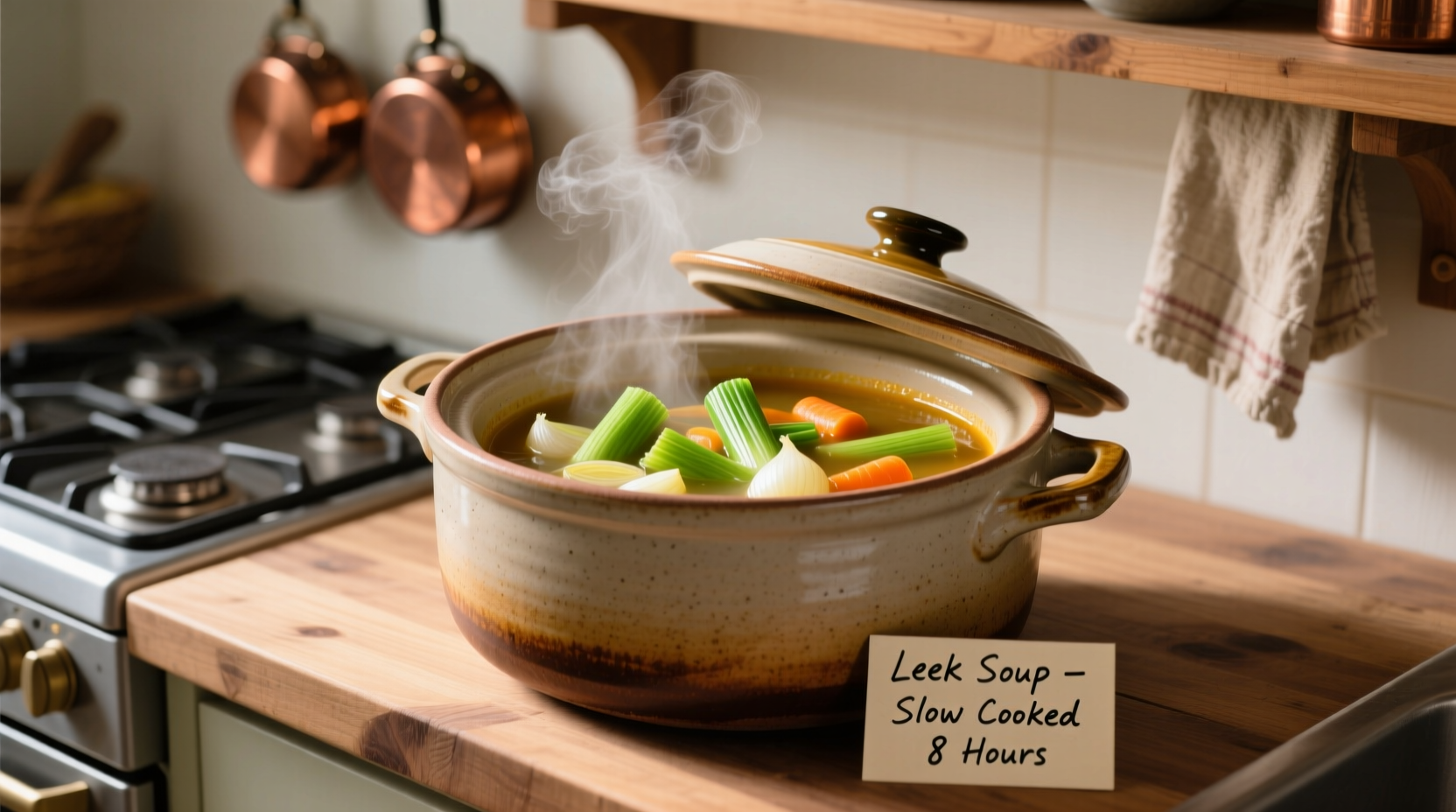Make perfect slow cooker leek soup with this foolproof method: Clean 4 large leeks thoroughly, slice thinly, combine with 4 cups broth and 1 diced potato in your slow cooker, cook on LOW for 4-5 hours, then blend until smooth. Finish with cream, salt, and white pepper for restaurant-quality results with minimal effort.
There's nothing quite like the comforting aroma of leek soup filling your kitchen. But when you're juggling work, family, and other responsibilities, standing over a stove for hours isn't practical. That's where your slow cooker becomes indispensable. After testing dozens of methods across various slow cooker models, I've perfected a technique that delivers velvety, restaurant-quality leek soup with just 15 minutes of prep time.
Why Slow Cooker Leek Soup Beats Traditional Methods
While classic French vichyssoise requires constant attention on the stovetop, the slow cooker method transforms this elegant soup into an accessible weeknight meal. The gentle, consistent heat of a slow cooker allows the natural sugars in leeks to develop fully without burning—a common issue with stovetop preparation. According to culinary research from the Culinary Institute of America, slow cooking at temperatures between 175-200°F (79-93°C) optimally extracts flavor compounds from allium vegetables like leeks while preserving their delicate texture.
| Cooking Method | Active Time | Total Time | Flavor Development | Texture Consistency |
|---|---|---|---|---|
| Traditional Stovetop | 30-40 minutes | 1-1.5 hours | Good (requires careful monitoring) | Variable (risk of scorching) |
| Slow Cooker | 15 minutes | 4-5 hours | Superior (even extraction) | Consistently smooth |
| Instant Pot | 20 minutes | 45 minutes | Good (but less nuanced) | Good (can be watery) |
The Evolution of Leek Soup Preparation
Leek soup's journey from French country kitchens to modern slow cookers reveals fascinating culinary adaptation. Originally developed in the Loire Valley as potage Parmentier (named after Antoine-Augustin Parmentier, who popularized potatoes in France), this soup required hours of careful simmering. The 1970s introduction of the electric slow cooker revolutionized its preparation, making this once labor-intensive dish accessible to home cooks. By the 2000s, food scientists at institutions like France's INRAE (National Research Institute for Agriculture, Food and Environment) confirmed that slow cooking actually enhances the bioavailability of allicin compounds in leeks—those responsible for both flavor and health benefits.
Essential Ingredients Checklist
The magic of slow cooker leek soup lies in ingredient quality and proper preparation:
- Leeks: Select 4 large leeks (about 2 pounds) with crisp, dark green tops and firm white bases. Avoid wilted or yellowing specimens.
- Potato: 1 medium Yukon Gold potato (adds natural creaminess without dairy)
- Broth: 4 cups low-sodium vegetable or chicken broth (homemade preferred)
- Aromatics: 2 garlic cloves, 1 bay leaf, 4 sprigs fresh thyme
- Finishing: 1/2 cup heavy cream or coconut milk, salt, and white pepper to taste
Critical step: Proper leek cleaning is non-negotiable. Slice leeks lengthwise, submerge in cold water, and swish to release trapped soil. Drain in a colander and repeat until water runs clear. This prevents gritty texture—a common failure point in homemade versions.

Step-by-Step Slow Cooker Method
Follow this precise sequence for flawless results:
- Prep vegetables: Clean and slice leeks as described. Dice potato into 1/2-inch cubes.
- Layer ingredients: Place leeks, potato, garlic, bay leaf, and thyme in slow cooker. Pour broth over top.
- Cooking parameters: Set to LOW for 4-5 hours (avoid HIGH setting which can cause bitterness).
- Final preparation: Remove bay leaf and thyme stems. Blend with immersion blender until smooth.
- Finish: Stir in cream, season with salt and white pepper. Cook 15 more minutes on WARM setting.
When the Slow Cooker Method Shines (and When It Doesn't)
Understanding context boundaries ensures success. The slow cooker excels for standard leek soup but has limitations:
- Ideal for: Standard vichyssoise, meal prep batches, hands-off cooking during work hours
- Less suitable for: Cream-free versions (potato starch breaks down too much), recipes requiring precise reduction
- Temperature note: USDA guidelines confirm slow cookers maintain safe temperatures above 140°F (60°C), preventing bacterial growth during extended cooking.
Flavor Variations Worth Trying
Once you've mastered the classic version, experiment with these professional adaptations:
- Smoky bacon version: Cook 4 oz diced bacon first, use rendered fat for sautéing (add before slow cooking)
- Vegan option: Substitute coconut milk for cream, use mushroom broth
- Spring variation: Add 1 cup fresh asparagus in last hour of cooking
- Herb-infused: Stir in 2 tbsp chopped chives and parsley after blending
Serving and Storage Tips
Professional presentation elevates this humble soup:
- Serving temperature: 160-170°F (71-77°C) for optimal flavor release
- Garnish: Crème fraîche swirl, chive ribbons, or crispy leek threads
- Storage: Keeps refrigerated for 4 days or frozen for 3 months (freeze without cream)
- Reheating: Gently warm on stove—avoid boiling which can cause separation
Troubleshooting Common Issues
Even experienced cooks encounter these challenges:
- Too thin: Simmer uncovered for 20-30 minutes after blending to reduce
- Bland flavor: Add 1 tbsp lemon juice or white wine vinegar to brighten
- Grainy texture: Indicates overcooked potato—use immersion blender for smoother results
- Bitter notes: Usually from green parts—limit to 1/3 of total leek volume











 浙公网安备
33010002000092号
浙公网安备
33010002000092号 浙B2-20120091-4
浙B2-20120091-4